Project Management Ultimate Guide
From the construction of ancient monuments to the industrialization of the 18th and 19th centuries, project management existed long before the term was introduced. However, it wasn’t until the 20th century, with new concepts such as the Critical Path and the Theory of Constraints, that project management emerged as a distinct profession in itself.
Since then, the concept of project management has become a force for positive change in the modern world. In fact, its pervasive success has led to what is termed ‘the project economy’, where projects are the engine behind how work is completed, how accomplishments are won, and how products are made.
Modern developments, such as computer software, have transformed project management into a powerful toolkit for achieving positive change. Here, we take a comprehensive dive into the field of project management, exploring the benefits, components, phases, approaches, techniques, tips, software, and career opportunities.
What is Project Management?
Simply put, a project is a series of tasks that need to be completed to reach a specific outcome – often within an agreed budget and timeline defined by a company’s clients and/or stakeholders. These tasks are usually carried out by a team, but can also be the responsibility of an individual.
Projects differ from other business functions in that they terminate in a deadline, rather than being continuous or repeating regularly, and focus on a final deliverable – a product, service, or result.
Project management is the leading of a team to complete a project’s objectives within the given cost and time.
Due to the finite timespan and involvement of external stakeholders, the project manager role diverges from that of a regular manager: it requires the application of certain methods, processes, skills, and knowledge, in order to achieve the project’s goals.
Some projects are needed to resolve acute problems quickly, and any improvements are made later over a period of time, such as building a piece of software. Others have a longer duration and/or produce an outcome that doesn’t need improvement except for maintenance, such as the construction of a highway.
Project Components
A number of different components are used to constitute a project. And although there are components that are dependent on the nature of a project, there are four components that every project includes:
- Tasks break down a project’s work into manageable parts. This enables project managers to plan, schedule, and execute the phases. Tasks have a duration or a time estimate attached to them.
- Goals form the overall result you want to achieve in the future and define where the project is going. For example, a project for building an online education platform might have a goal to release three new courses, but a milestone when it reaches 100,000 subscribers.
- Milestones are specific points within a project that measure progress toward goals. They delineate project phases and serve as checkpoints on the project timeline. They act as signal posts that mark significant events or branching decision points and are used for events such as start and end dates, external reviews, budget checks, or submissions of major deliverables.
- Deliverables are outputs of the project. These can be internal (for use among project teams) or external (provided to a client or stakeholder). A deliverable is a quantifiable result, whereas a milestone is an important moment in the project’s timeline. Sometimes, however, these can overlap. For example, completing the first prototype is also a milestone.
The Benefits of Project Management
Projects are used to produce a result which advances an organization. For a business, this is typically to gain a competitive advantage and ultimately to elevate profitability.
Project management is the process by which project gains are maximized while losses are minimized, therefore, benefits the organization via improved outcomes.
However, there are many other advantages to project management.
Improved decision-making
Thorough planning improves decision-making and, therefore, the accuracy of the project’s scope, schedule, and budget. For example, confusion over who is accountable is a significant cause of poor decisions and delays. But establishing role clarity during the planning phase can quickly eliminate this.
Reduced cost and time
A clearly defined project with accurate estimations and continued tracking improves adherence to budget, timescale, and scope. Resources are used more efficiently and effectively over time.
Further, a project template supported by consistent processes can be re-used for multiple projects, which speeds up the initiation phase.
Increased client satisfaction
Project management maintains the clarity of the project’s purpose and goals. Deliverables are agreed upon with the client from the outset and made sure to satisfy the different needs of different stakeholders.
Greater productivity and quality of work
Good project management means that team members better understand their personal responsibilities, deliverables, and schedule. What’s more, consistent communication between team members improves collaboration, which in turn improves performance.
Mitigated risk of failure
Risk management processes help anticipate problems and ensure preparation for them. This, combined with better communication, ensures there are no unforeseen obstacles along the way.
Continued insights
Project management provides insights not only into the individual project but how it fits in with the broader business strategy. It also provides documented lessons that can benefit future projects.
The Project Life Cycle
Managing a successful project isn’t easy. Meeting the various expectations of clients and stakeholders, managing a disparate team, and the sheer number of tasks involved mean there is a lot for project managers to think about.
Although different sectors use project management, the presence of common components between projects has resulted in the development of a systematic framework called the ‘project life cycle’.
The project life cycle helps project managers transform a concept into reality in an orderly and efficient way and increase the chances of successful completion. It consists of a set of distinct, high-level phases.
Breaking down a project into phases and treating these separately benefit the management process in several ways. It makes communication between stakeholders and team members easier, ensures goals are achievable with the available resources, helps mitigate risk, and keeps the project on track. A phase is completed when the specific deliverables are handed off.
There is no compulsory number of phases that project managers should use, which will usually depend on the nature of the particular project. However, the PMI has outlined five project phases that are relevant to almost every undertaking.
1. Initiation
Project initiation is about determining the nature and scope of the project, and the value it will deliver to the organization.
During this phase, the project’s feasibility is assessed to determine whether it can succeed at an acceptable cost and timespan. This is where brainstorming meetings take place, ideas are explored, and preliminary research is conducted.
The deliverable at the end of this stage is a set of documents that establishes the order of tasks. This creates the baseline needed to begin work but also provides information about the processes for incorporating changes should they arise.
Each document within the project plan encompasses a different aspect of the work. They may include any of the following:
- Project proposal – Document defining your project, including start and end dates, objectives, and goals. They act as a business case to justify the project.
- Scope statement – Outline of the entire project, including any deliverables and a list of stakeholders who are affected. Learn how to create a successful project scope.
- The responsibility assignment matrix (RACI) outlines who is responsible and accountable for each task and who needs to be consulted and informed.
- Tentative project schedule – Outlines the most important dates, all milestones, and tentative deadlines.
2. Planning
The planning phase is where the entire project roadmap is created, so it requires the utmost diligence. This phase involves in-depth research, identifying technical requirements, adjusting some of the documentation created in the initiation phase, and building detailed strategies. The project manager typically holds a kickoff meeting with the project team to outline the goals, schedule, and processes.
Planning usually consists of the following activities:
- Selecting the planning team
- Integration management (ensuring that team members fit well alongside each other)
- Procurement of resources
- Determining the project management methodology
- Developing the scope statement
- Identifying deliverables and creating the work breakdown structure
- Identifying the activities needed to complete those deliverables and networking the activities in their logical sequence
- Developing quality assurance measures
The deliverables of this phase are a number of detailed plans, which may include the following:
- The communication plan describes how team members and stakeholders will communicate throughout the project timeline.
- Risk assessment and management plan. Anticipation of any problems, with preparation and allowances to recover if these occur.
- A project plan is a blueprint for how the entire project will be carried out, including the budget, schedule, time and cost estimations, resource requirements, etc. Learn how to create a perfect project plan.
- Work Breakdown Structure (WBS). A hierarchy of the work to be done and its dependencies. This breaks down deliverables into tasks, then assigns these to team members.
- Gantt chart provides a view of the whole project timeline and all of its dependencies.
By the end of the planning phase, the team members and stakeholders should clearly understand the project’s objectives, timeline, and personal responsibilities. The completion of planning is marked by formal approval to begin work.
Read on: What Is a Work Breakdown Structure in Project Management?
3. Execution
This is when the project team carries out the work, implementing the plans accordingly. The role of the project manager is to establish effective workflows for the team and maintain collaboration between project stakeholders. This ensures that everyone remains informed and the project runs smoothly.
The project manager must provide leadership, communication, and motivation to the team, and there are specific aspects that require oversight during this phase.
4. Monitoring & control
This is sometimes bundled with the execution phase since monitoring and control processes run concurrently with implementation. However, it is considered separately, to emphasize the importance of monitoring. This phase is about tracking progress, reporting, proactively identifying issues, and taking steps to resolve them.
Deliverables at the monitoring phase generally run throughout and include:
- Team meetings help the team stay on track (so long as they are efficient and useful).
- Stakeholder updates help avoid misunderstandings and manage expectations.
- Quality assurance – it is important to review deliverables before sending them to the next phase to avoid bottlenecks.
- Progress reports provide a general overview of the project’s status.
- KPI reports – monitoring KPIs ensures the project remains on track.
The end of the execution and monitoring and control phases is usually marked by the completion of all project tasks.
5. Closure
This is the final phase of the project life cycle. It involves formally presenting the final deliverable to the client, as well as closing the project in a controlled fashion. Care is needed to ensure all project requirements and legal obligations have been met.
The closing phase typically consists of the following activities:
- Transfer of deliverables – once the final deliverable has achieved the project’s objectives, it can be formally handed to the client and any other parties.
- Confirmation of completion (for team members) – formal sign-off must be given by all stakeholders and team members. This is to avoid confusion and last-minute changes.
- Contract closure (for suppliers) – this involves the resolution of any open items, and completion and settlement of each contract.
- Review of documentation (for project managers) involves reviewing all contracts and documentation to check sign-off has been completed.
- Release of resources – before a project is marked as complete, the project team and suppliers must be officially released from work. There is normally a process in place to notify all parties and ensure payment is complete.
- Project closure – in which all activities for all teams must be finalized. Don’t forget to celebrate a successful completion with your team!
Project Management Methodologies
Over the years, various project management methodologies have been developed to be more effective in different sectors or types of projects. All approaches consist of distinct phases, but not all are structured linearly.
The most suitable project management methodology is dependent on the sector, project size, and nature of the work.
While several approaches exist, project management methodologies can be broadly divided into two families: ‘traditional’ and ‘agile’.
Traditional methods
Traditional models follow a more rigid, longer-term process. They are characterized by a slower feedback loop, fixed roles for team members, and prioritization of processes and tools.
Due to these properties, traditional methods tend to work well for well-defined projects with limited, well-understood variables.
Waterfall
Waterfall projects proceed in a linear, one-directional fashion, where each phase is completed before cascading into the next, much like a waterfall. This system emphasizes exact planning and originates from the manufacturing and construction industries, where design changes are expensive once execution begins.
The Waterfall model consists of six phases:
- Define requirements
- Design the workflow system
- Implement the workflow and build
- Test each element of the product or service
- Deliver the product or deploy the service
- Provide ongoing maintenance
PRINCE2
PRINCE2 stands for PRojects IN Controlled Environments, mark 2, and was originally developed as a UK government standard for information systems projects.
PRINCE2 approach is similar to Waterfall, but it uses seven phases:
- Present an outline to a board that determines the viability
- Identify scope and risk, and create a plan
- Obtain authorization and direction from the board
- Delegate work and monitor progress
- Deliver the product or deploy the service
- Review performance
- Evaluate success
Agile methods
Agile models involve rapid and iterative responses to change. They are characterized by a faster feedback loop, team collaboration, and prioritization of individuals and interactions.
Agile approaches are cyclical, iterative procedures and typically use a technique called ‘fast tracking’, where traditional phases overlap.
These models have gained popularity in recent decades because they allow greater flexibility. Agile methods work well for complex projects with multiple interconnected phases and changing requirements, budgets, and costs.
Read on: Agile Project Management: What Is It and Why Does It Matter?
Kanban
Kanban takes a visual approach to project management that shows team members all of the project’s tasks, workflow, and progress. Team members then select tasks as capacity permits, rather than using a set schedule, the goal being to improve decision-making and handle bottlenecks.
The phases of Kanban are:
- Visualize workflow using a Kanban Board (showing to-do, in-progress, and completed tasks)
- Limit in-progress tasks
- Manage workflow and adjust
- Clarify processes for the team
- Add feedback loops for swift course correction
- Collaborate and experiment for continuous improvement
Scrum
Scrum is an iterative and incremental framework that originated in software development. The term is taken from the formation of players in rugby and was chosen for its emphasis on teamwork. The Scrum approach divides projects into shorter ‘sprints’ of work which generally last one to four weeks, and is designed so that the team can adapt to the changing demands of an evolving project.
The phases of Scrum are:
- Define requirements (as part of sprint planning)
- Update to-do list to prioritize team tasks
- Plan a sprint of work
- Perform the sprint with daily meetings to discuss and review objectives
- Carry out the sprint review
- Carry out the sprint retrospective
Lean
Lean project management is more of a set of principles than a model and is based on systematically maximizing the value of the result while minimizing waste. The principles originated from the Toyota Production System, which was then generalized into the lean methodology. It aims to eliminate waste (‘muda’) by designing out overburden (‘muri’) and inconsistency (‘mura’).
The process is generally as follows:
- Define value for the client
- Map the ‘value stream’ (the sequence of tasks involved in generating the deliverable)
- Remove waste (anything which does not add value, hinders workflow, or is unnecessary or harmful management)
- Respond to client demand for just-in-time delivery
- Continuously improve
Read on: Which Project Management Methodology is Right for Your Team?
Project Management Techniques
In addition to different project management methodologies, there are several techniques used to augment the project management process. These can be thought of as optional ‘add-ons’ to the baseline methodology.
The Gantt chart
The Gantt chart is a horizontal bar chart that illustrates a project schedule and is used to visualize project timelines and schedules.
The vertical axis shows the project divided into tasks, while the horizontal axis shows time. Each task is represented by a horizontal bar, which is usually color-coded, while the length of each bar shows the task’s estimated duration.
Within the Gantt chart, tasks are classified as either summary elements or terminal elements:
- A summary element is a larger task within the project. If we take ‘manufacturing a car’ as a project, a summary element could be painting the car.
- Terminal elements are the smaller tasks involved in painting a car, such as applying the primer, the first coat of paint, the second coat, the wax, and the buff.
Besides the main elements of the Gantt chart, there are various optional features that can benefit teams:
- Progress indicator – in which element bars can be shaded or filled according to their degree of completion.
- Dependencies (or links) – relationships between elements typically shown as ‘elbow arrows’ connecting the corresponding ends of two tasks. There are four types of dependencies:
- Finish-to-Start – the preceding task must be completed before another task can begin.
- Start-to-Start – the task cannot begin before the preceding task begins. Once the preceding task starts, the two tasks can run independently.
- Finish-to-Finish – the task cannot end before the preceding task ends. However, the two tasks don’t have to end simultaneously.
- Start-to-Finish – In some cases, the preceding task must start before the other one can finish.
- Milestones – these are usually represented by a diamond ◇, which is filled when the milestone is achieved ◈.
- Assignments – an element can be assigned to a specific person, team, or department. This is usually shown as a label to the right of the element’s bar.
The Gantt chart has a number of uses:
- During the planning phase, it helps assess the project’s duration, order of tasks, staff involved, and the resources required.
- In the monitoring & control phase, the Gantt chart helps visualize progress. So if the project is falling behind schedule, it shows what is needed to put it back on track.
- During the closure phase, the original and final charts can be compared for analysis, showing which tasks were completed on schedule, and which were delayed and why. These insights help improve planning accuracy for future projects.
Benefits Realization Management (BRM)
Sometimes, a project which successfully delivers the agreed outputs can fail by falling short of the required outcomes (benefits).
Benefits Realization Management is designed to measure and control how a project adds value to the organization conducting it.
It focuses on the outcomes of a project rather than the deliverables and estimates the degree to which a project can achieve these. Research into the strategic impact of BRM has shown that its usage increases the chances of project success.
The PERT chart
The Project Evaluation and Review Technique (PERT) chart is a visual representation of the series of events within a project’s life cycle.
A PERT chart can be used for what-if (sensitivity) analysis and helps the project manager to estimate the time and resources needed and track required assets during different stages.
However, the chart’s effectiveness is dependent on the reliability of the data and the accuracy of the estimations. To remain useful, PERT charts must be continually reviewed and updated. The maintenance of disparate information from different departments, combined with the shifting position of the project, can be labor-intensive.
Critical Path Method (CPM)
A ‘critical’ task must be completed to finish the project by its deadline, and the ‘critical path’ is the sequence of critical tasks which constitute the maximum time expected to achieve this.
Created during the planning phase, the CPM, or CPA (Critical Path Analysis), is the process for determining this sequence, and works in conjunction with the PERT chart.
Earned Value Management (EVM)
EVM uses the triple constraints of time, cost, and scope to measure project performance. Partway through the schedule, EVM uses the project’s planned and actual values of cost and time to predict their future values and enables project managers to adjust to keep on track.
- Planned Value (PV) is the project’s estimated time or cost and is also known as the Budgeted Cost for Work Scheduled (BCWS). It varies based on the scope of the project and the point in the schedule.
- Actual Cost (AC) is the cumulative cost of all project activities completed to date and is sometimes known as the Actual Cost of Work Performed (ACWP). It is important to include any hidden costs, such as materials, software licenses, and overheads.
- Earned Value (EV) or the Budgeted Cost for Work Performed (BCWP).
- Schedule Variance (SV) indicates the project’s degree of divergence from the planned schedule. A negative SV indicates the project is behind schedule, a positive SV indicates it is ahead of schedule, and an SV of zero indicates it is exactly on schedule.
- Cost Variance (CV) indicates the project’s degree of divergence from the planned budget. A negative CV indicates the project is over-budget, a positive CV indicates it is under-budget, and a CV of zero indicates it is exactly on budget.
- Schedule Performance Index (SPI). Sometimes indexes are used as indicators instead of variances. An SPI greater than 1 indicates the project is ahead of schedule, while an SPI less than 1 indicates the project is behind schedule.
- Cost Performance Index (CPI). A CPI greater than 1 indicates the project is under-budget, while a CPI less than 1 indicates the project is over-budget.
Critical Chain Project Management (CCPM)
CCPM is an alternate method to CPM of estimating the time required to finish a project. While CPM and PERT charts focus on task order and a rigid schedule, CCPM emphasizes the resources (personnel, equipment, and physical space) required to complete tasks, and is more flexible than conventional methods. Research has found that CCPM increases project speed and reduces cost.
Resource-dependent tasks often slow the pace of project progress. The ‘critical chain’ is the sequence of these tasks which prevent the project from being completed in a shorter time span. CCPM makes use of the theory of constraints, where a small number of tasks have an inordinate impact on achieving project objectives. Therefore, it makes sense to prioritize these tasks. The CCPM method seeks to eliminate padding task duration, starting tasks too early, and multitasking, since these can lead to schedule uncertainty.
Six Sigma (6σ)
Six Sigma (6σ) is a doctrine originally developed for manufacturing at Motorola in 1986. The term comes from statistical quality control: the target upper and lower specification limits are each six standard deviations (σ) away from the mean, which results in 99.99966% of all products being free of defects.
Applied to project management, Six Sigma is a data-driven technique used to improve the quality of project processes by removing the causes of defects and variability. It uses two methodologies: DMAIC and DMADV.
DMAIC (“duh-may-ick”) is used to improve existing processes. Its stages are:
- Define the process, requirements, and objectives
- Measure key aspects of the current process and collect data, then calculate the process’ existing capability
- Analyze the data to identify the root causes of defects
- Improve the process based on the results of testing alternative methods
- Control the process to ensure any deviations from the specification are corrected
DMADV (“duh-mad-vee”) is used to create new processes. Its stages are:
- Define the process’s goals
- Measure the values of factors that are Critical-to-Quality (CTQs)
- Analyze the data and develop alternatives
- Design an improved version based on the alternatives
- Verify the design is acceptable to stakeholders by carrying out pilot runs
Effective Project Management
Understanding the phases of a project is a good start, but there are a number of tips and techniques available to make these phases more effective.
1. Initiation
Once deliverables have been defined, and the project has been deemed feasible and cost-effective, it is crucial to choose the most applicable project management model. This will depend on the industry, scope, workflow, and project team.
The model requires careful consideration since it determines the planning, team hierarchy (if any), how deliverables are produced, and the monitoring & control processes. The CPM and CCPM methods can provide insights to aid in the selection of a suitable model.
2. Planning
Planning involves constructing a detailed project schedule, which requires establishing a number of interim goals for the team. However, these must be clearly defined and achievable.
Collections of criteria have been developed to help set goals, for example, the SMART and CLEAR frameworks. SMART is a more traditional method, whereas CLEAR is a more modern alternative, which aims to work better with faster, more agile projects.
SMART:
- Specific – Clear and unambiguous
- Measurable – Results can be measured quantitatively
- Attainable – Realistic and achievable by the team members executing the goal
- Relevant – Relate to the project’s objectives and vision
- Time-bound – Have definite start and endpoints
CLEAR:
- Collaborative – Encourage teamwork
- Limited – Constrained in both duration and scope
- Emotional – The team members executing the goal are emotionally connected to it
- Appreciable – Large goals can be divided into smaller parts to be achieved more easily
- Refinable – Flexible enough to be modified if required
3. Execution
Since the execution phase is where the work is carried out, it is important for the project manager to work closely with all teams and team members to ensure they follow the schedule and understand their roles.
Project management includes a multitude of roles, so it is usually a good idea to delegate some tasks to team members to keep a clear head. This has the added benefit of building the team member’s confidence since they can make a larger contribution to the success of the project.
Other tips for project managers during execution are:
- Distribute information to stakeholders and the client, involving them in the decision-making process.
- Assign and maintain clear responsibilities, and hold those team members accountable.
- Remember to explain the reasoning behind decisions to encourage acceptance from the team.
4. Monitoring & control
If someone falls behind schedule or there is an unforeseen problem, this needs to be identified and resolved ASAP. Therefore, it is important to establish Critical Success Factors (CSFs) and KPIs to detect when this occurs.
When too many changes accumulate in a project, its viability may need to be re-assessed. If these changes are valid but do not fall within the agreed bounds of the project’s elements, such as time and budget, then the forecasted result may not justify the original proposed investment in the project.
Successful project management identifies these components, and tracks and monitors progress, to stay within time and budget frames already outlined at the commencement of the project.
One major problem to watch out for is ‘scope creep’, which according to the PMI is “the uncontrolled expansion of project scope without adjustments to time, cost, and resources”. Research by the organization has found that more than half of all companies experience scope creep.
Scope creep can cause the following difficulties:
- Misalignment of work with the project’s goals and requirements
- Problems that delay delivery
- Numerous changes
- Increase in time overage and resource fatigue
While the steps taken during the initiation and planning phases should minimize scope creep, it can sometimes manifest during execution, which is why it is important to monitor it. Risk management enables project managers to detect when a mitigation plan should be deployed to get the project back on track. The key is to recognize early red flags, such as an uptick in requests or changes, delays, or quality degradation.
5. Closure
Even though the closure phase may seem filled with formalities and paperwork, it has importance for future endeavors because project managers continually take on new projects. If the project is replacing an existing process or technology, you need to decide when to phase out the old design.
It is useful to learn from everything possible from each completed project, so analyze the outcomes and the experience of the team. This debriefing process is sometimes referred to as the project’s ‘post-mortem’.
It is good to have a retrospective meeting, where team members can communicate their successes and failures while these experiences are still fresh in their minds. Note what worked and what didn’t, so you can repeat successes and avoid the same mistakes again.
Future projects are more likely to be successful if you can develop a standardized process for managing the entire life cycle.
Effective team management
Aside from the capability of the project manager, the most important factor in project success is the effectiveness of its team. This can be maximized in the following ways:
- Recruit talent across departments because projects require varied expertise and input from different stakeholders.
- Identify the right team members to create deliverables and define a workflow for decisions and approval.
- Define how the team will share and collaborate on documents, where documents will be stored, and how they will be controlled.
- Hold planned and regular meetings to ensure your team is always aligned.
- Encourage communication throughout the entire project lifecycle.
What is Project Management Software?
What is project management software?
Project management software is the implementation of project management processes in computer software and is a platform to plan, monitor, and report on projects.
Since project activities are labor-intensive and often codependent, performing them manually and communicating changes involves a lot of working hours. Therefore, distributed software on team members’ workstations is used to drastically speed up these activities.
The benefits of using project management software
Modern project management software includes estimation and planning, scheduling, budget management, time management, resource allocation, collaboration and communication, documentation, and reporting. Essentially, all the common project management processes and techniques discussed thus far are present in a comprehensive solution.
The advantages of project management software are manifold:
A single source of information – When data is scattered across various departments involved in a project, it leads to information becoming inaccurate or incomplete. Project software unifies data and provides a single source of truth, as well as making it more accessible to all team members.
Precise progress tracking – Project management software provides a complete project overview, showing the progress of tasks and who is assigned to them. Not only does this eliminate the need for lengthy status updates, but a good solution will also provide alerts ahead of time when something needs attention.
Digital tools – More comprehensive software include digital versions of project management tools, such as the Gantt chart, PERT chart, dashboard, task list, and Kanban board. These can be automatically updated and the changes instantly communicated with the rest of the team, without them having to be redrawn manually.
Integrated functionality – Accomplishing tasks usually involves different software applications, and switching between them slows work down. A well-considered software includes a comprehensive suite of tools – all in one place and at the team’s disposal.
Automatic reports – Since project management software gathers all available data into a single solution, it can easily generate progress reports in different formats, as required.
Seamless continuity – Cloud-based project management software enables team members to login and pick up work on any computer, even if their everyday machine is out of action, or if they’re on the go.
How to choose project management software
With so many solutions out there, it can be difficult to know where to start. The following steps can help narrow down the list:
- Conduct a needs analysis – Determine what users across the organization require. It is important to ask what current processes are, what features are desired, and what the pain points and inefficiencies are in current workflows.
- Prioritize requirements – Use the data from the needs analysis to compile a list of the top features.
- Ensure integration – Select project management software that can be integrated with existing core technologies.
- Test solutions – Most vendors provide free trials before a long-term commitment. Although testing may take time, the more thoroughly a solution is explored, the less likely there will be any unforeseen issues when it is implemented. Learn how to get the most of your free trial.
- Compare solutions – take a systematic approach using the top requirements and trial results. Remember to select a solution that has a good level of vendor and community support, so that questions can be answered helpfully and quickly when they arise.
Remember that implementing PMS in your organization is a project in itself, so requires careful consideration, plenty of time, and assignment of resources. Provide thorough training sessions for users, and ensure everyone has an account and login credentials by the end of their training, so they can get started straight away.
Best Project Management Software
1. Scoro
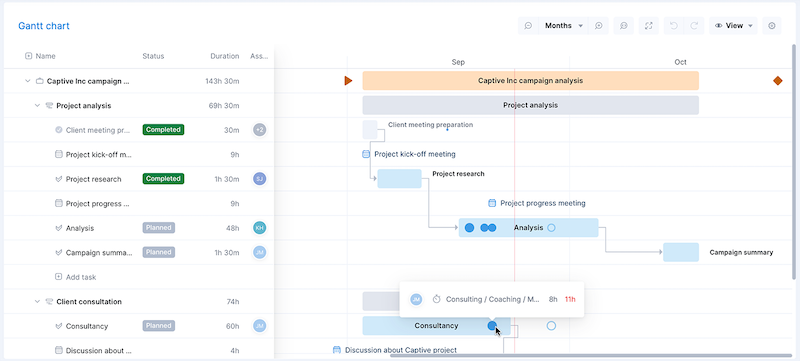
Scoro is the industry-leading work management software that helps creative and professional service businesses streamline projects, automate quoting and billing, optimize utilization, and much, much more.
Top features:
- Projects with sub-tasks and deadlines
- Real-time KPI dashboard
- Contact management
- Time tracking
- Gantt chart
- Quoting and invoicing
What’s unique about it: Scoro brings all the main business functions into one application. Other software providers claim to do this, but none of them truly achieve it in the same manner.
Pricing: Free 14-day trial, paid plans from $26 user/month
2. Jira
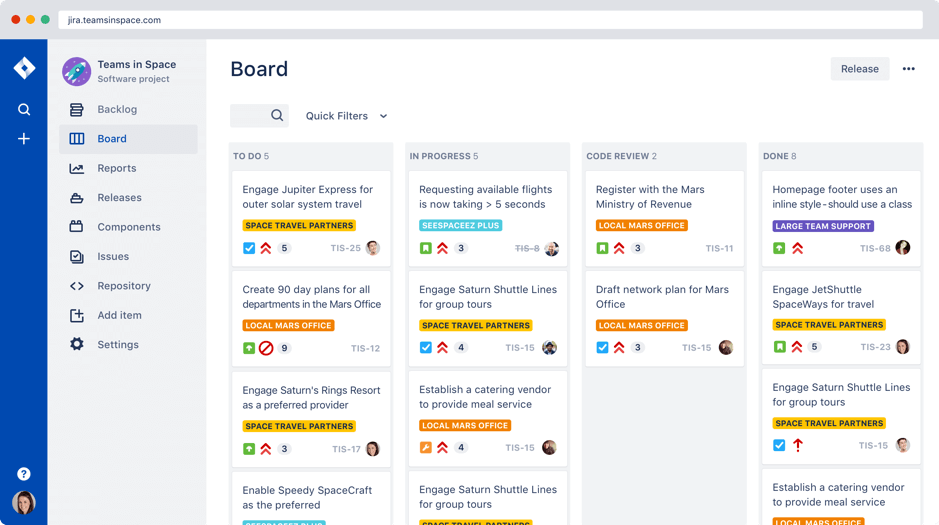
Jira is a cross-platform issue and bug tracking software with advanced project management capabilities and features.
Top features:
- Agile-focused approach
- Project tracking
- Mobile device support
- Extensive reporting functionality
- A multitude of flexible APIs
What’s unique about it: Flexibility. Jira leverages multiple project management SaaS tool protocols, including scrum management, marketing, professional services, and more.
Pricing: Free trial, paid plans from $7 user/month
3. Basecamp
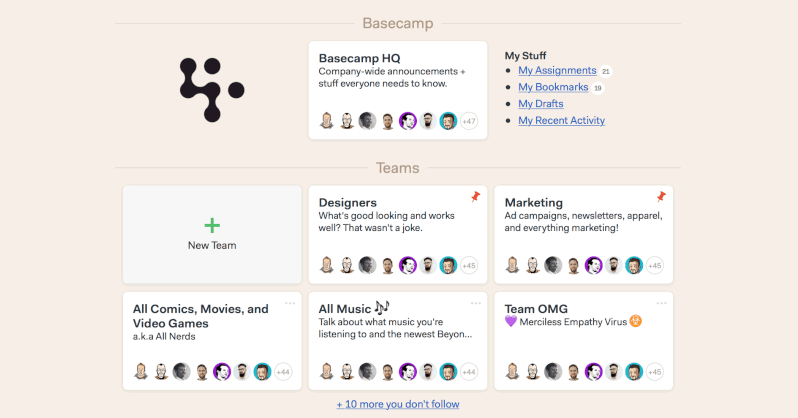
Basecamp is the preferred tool for project management teams who enjoy its modern social media-like interface and carefree team collaboration features.
Top features:
- Client Portal
- Message boards
- In-app collaboration with the team
- Separate dashboard for showing to clients
What’s special about this tool: Basecamp has exclusive deals for teachers, students, and non-profits.
Price: $99/month
4. ProofHub
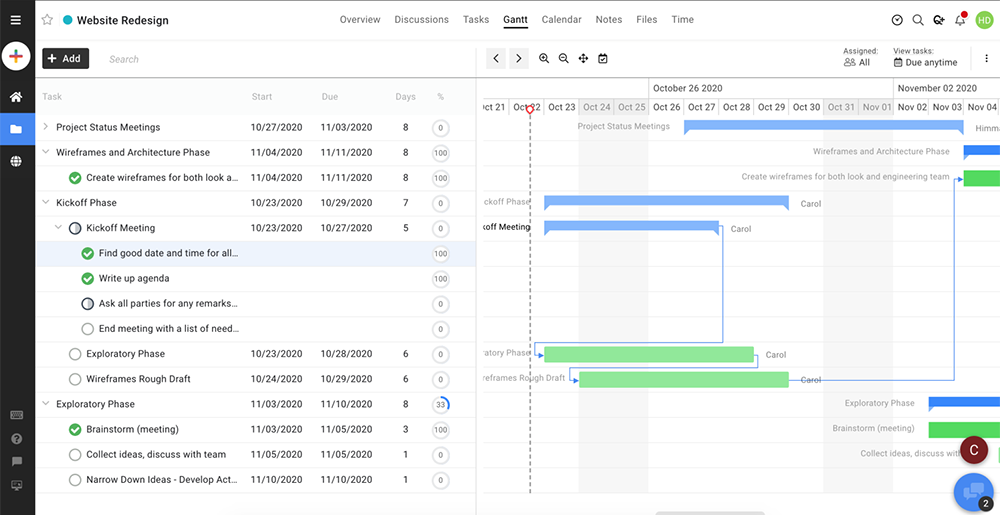
ProofHub is a flexible project management solution that enables teams of all sizes to collaborate and communicate in real time.
Top features
- To-do lists and notes
- Tasks, sub-tasks, and add comments
- Defined deadlines
- Reminders and events in the calendar
What’s special about this tool: ProofHub gives project managers ultimate controls over who gets access to specific tasks.
Pricing: Free 14-day trial, paid plans from $45 per month
5. Bitrix24
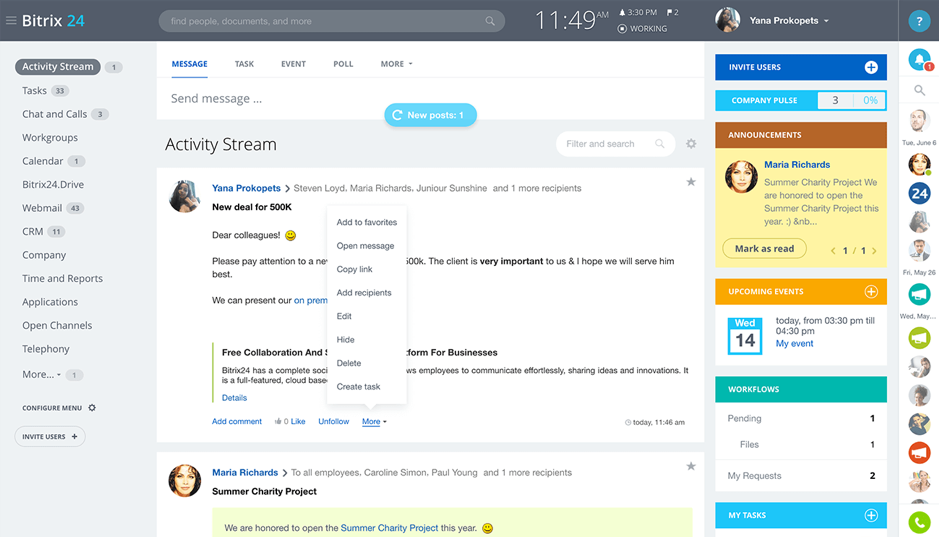
Bitrix24 is social enterprise software that offers a complete suite of social collaboration, communication, and management tools for your team.
Top features
- Unlimited calendars & appointments
- Calendar access rights
- Invoicing
- CRM
What’s special about this tool: Bitrix24 has a broad set of features, from traditional project management to integrated telephone and HR systems or internal email.
Pricing: Free trial available, paid plans from $12 user/month
Also, check out the complete list of 42 Best Project Management Software and Tools!
Trends in Project Management
Although project management has been transformed by software implementations, this won’t be the last revolution in the industry. Organizations should therefore be aware of changes on the horizon, and proactively prepare for them where possible.
Artificial intelligence (AI) and data analytics
AI, and more specifically machine learning (ML), has had a huge impact on many modern fields, from autonomous vehicles to video enhancement.
While it is not clear exactly how AI will be used in project management, nearly all leaders in the field believe it will have an impact. PMS generates huge amounts of data that can be fed into ML algorithms, so it is expected that processes that are currently performed manually, such as task scheduling and CCPM, will become automated before long.
Further, the rise of data analytics tools and analysts will likely mean that more sophisticated insights will be drawn from this information. For now, it is a good idea to consult researchers and industry leaders in order to identify the most likely areas of automation, then incorporate this knowledge into your professional training.
Hybrid project management models
Organizations are always seeking project flexibility, and this has resulted in teams experimenting with the combination of traditional approaches and agile methods. Since these models have different advantages, the aim is to combine the best of both worlds.
For example, the project plan may be meticulously composed in the planning phase of a waterfall structure, but also be periodically reviewed and updated throughout the project (in a more circular way).
Increased remote working
Although remote working has recently skyrocketed due to the COVID-19 pandemic, this had already been increasing for years. As of April 2021, 52% of US employees are working remotely, whereas only 7% even had access to this facility in 2018.
With some element of remote working here to stay, effective communication and collaboration via PMS will be even more vital to sustaining productivity.
It seems likely that a hybrid working routine will emerge, where employees can work from home but also be present on certain days. Rather than oppose this trend by trying to force their employees back to the office, it would be wiser for organizations to embrace hybrid working – or the ‘work from anywhere’ era – and instead find ways to make this new reality work effectively.
Emotional intelligence (EI)
As projects become more complex and interconnected, and teams become more diverse and dispersed, project managers will need to step up their collaboration and communication skills.
As a result, these soft skills will become even more important factors in determining a project’s success. Great project managers will need to draw on these skills to anticipate the needs of their team, understand their moods and motivations, and eliminate any issues before they adversely affect the project.
In fact, the PMI’s Pulse of the Profession report found that organizations are now prioritizing leadership skills (65%) almost as much as technical skills (68%). Even more markedly, a 2019 Businessolver study found that 91% of US CEOs believe that empathy is directly related to their company’s financial performance.
Conclusion
Although the field of project management is often perceived as disciplined, rigorous, and arduous, its illustrious history has proven it can improve the result of almost any working scenario. So while there may be lots to learn, a thorough knowledge of project management – and its applications – will always bring benefits to products, services, project managers, and enterprising organizations.
Scoro provides state-of-the-art project management software built upon the processes designed to maximize the success of any project. Start your 14-day free trial today!

